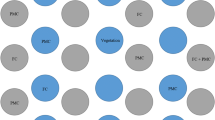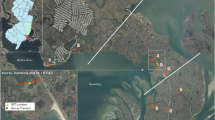Abstract
We compared the functions and values of fringing salt marshes to those of meadow marshes along the southern Maine/New Hampshire coast. Differences included soil organic matter content, plant species richness, and percent cover of high and low-marsh species. More sediment was trapped per unit area in fringing marshes than in meadow marshes, but this difference was not significant. Similarities included aboveground and belowground peak season biomass and the ability to dampen wave energy. Both marsh types reduced the height of waves coming onto the marsh surface by 63% only 7 m into the marsh. Fringing marshes are diverse in terms of their physical characteristics (width, length, slope, elevation, soils). Despite their small size, they are valuable components of estuaries, performing many ecological functions to the same degree as nearby meadow marshes. More effort should be made to include them in regional efforts to conserve and restore coastal habitats.









Similar content being viewed by others
References
Bozeck, C.M., and D.M. Burdick. 2005. Impacts of seawalls on salt marsh plant communities in the Great Bay Estuary, New Hampshire USA. Wetlands Ecology and Management 13(5): 553–568. doi:10.1007/s11273-004-5543-z.
Bricker-Urso, S., S.W. Nixon, J.K. Cochran, D.J. Hirschberg, and C. Hunt. 1989. Accretion rates and sediment accumulation in Rhode Island salt marshes. Estuaries 12: 300–317. doi:10.2307/1351908.
Bryan, R.R., M. Dionne, R.A. Cook, J. Jones, and A. Goodspeed. 1997. Maine citizens guide to evaluating, restoring, and managing tidal marshes. Falmouth: Maine Audubon Society.
Burdick, D.M., I.A. Mendelssohn, and K.L. McKee. 1989. Live standing crop and metabolism of the marsh grass Spartina patens as related to edaphic factors in a brackish, mixed marsh community in Louisiana. Estuaries 12(3): 195–204. doi:10.2307/1351824.
Cook, R.A., A.J. Lindley Stone, and A.P. Amman. 1993. Method for the evaluation and inventory of vegetated tidal marshes in New Hampshire. Concord: Audubon Society of New Hampshire.
Craft, C.B., E.D. Seneca, and S.W. Broome. 1991. Loss on ignition and Kjeldahl digestion for estimating organic carbon and total nitrogen in estuarine marsh soils: Calibration with dry combustion. Estuaries 14: 175–179. doi:10.2307/1351691.
Davis, J., B. Nowicki, and C. Wigand. 2004. Denitrification of fringing salt marshes of Narragansett Bay, Rhode Island, USA. Wetlands 24(4): 870–878. doi:10.1672/0277-5212(2004)024[0870:DIFSMO]2.0.CO;2.
Denny, M.W. 1988. Biology and the mechanics of the wave-swept environment. Princeton: Princeton University Press.
Donnelly, J.P., and M.D. Bertness. 2001. Rapid shoreward encroachment of salt marsh cordgrass in response to accelerated sea-level rise. Proceedings of the National Academy of Sciences 98(25): 14218–14223. doi:10.1073/pnas.251209298.
Ellison, A.M., M.D. Bertness, and T. Miller. 1986. Seasonal patterns in the belowground biomass of Spartina alterniflora (Gramineae) across a tidal gradient. American Journal of Botany 73(11): 1548–1554. doi:10.2307/2443921.
Ewenchuck, P.J., and M.D. Bertness. 2004. Structure and organization of a northern New England salt marsh plant community. Journal of Ecology 92: 72–85. doi:10.1111/j.1365-2745.2004.00838.x.
Gallagher, J.L., and H.V. Kibby. 1981. The streamside effect in a Carex lyngbyei estuarine marsh: The possible role of recoverable underground reserves. Estuarine, Coastal and Shelf Science 12: 451–460. doi:10.1016/S0302-3524(81)80004-7.
Gleason, M.L., D. Elmer, and N.C. Pien. 1979. Effects of stem density upon sediment retention by salt marsh cord grass, Spartina alterniflora Loisel. Estuaries 2: 271–273. doi:10.2307/1351574.
Gross, M.F., M.A. Hardisky, P.L. Wolf, and V. Klemas. 1991. Relationship between aboveground and belowground biomass of Spartina alterniflora (smooth cordgrass). Estuaries 14: 180–191. doi:10.2307/1351692.
Jacobson, H.A., and G.L.J. Jacobson. 1989. Variability of vegetation in tidal marshes of Maine, U.S.A. Canadian Journal of Botany 67: 230–238. doi:10.1139/b89-032.
Kastler, J.A., and P.L. Wiberg. 1996. Sedimentation and boundary changes of Virginia salt marshes. Estuarine, Coastal, and Shelf Science 42: 683–700. doi:10.1006/ecss.1996.0044.
Knutson, P.L., R.A. Brochu, W.N. Seelig, and M. Inskeep. 1982. Wave dampening in Spartina alterniflora marshes. Wetlands 2: 87–104.
Konisky, R.A., D.M. Burdick, M. Dionne, and H.A. Neckles. 2006. A regional assessment of salt marsh restoration and monitoring in the Gulf of Maine. Restoration Ecology 14(4): 516–525. doi:10.1111/j.1526-100X.2006.00163.x.
Leonard, L. 1997. Controls of sediment transport and deposition in an incised mainland marsh basin, southeastern North Carolina. Wetlands 17(2): 263–274.
Leonard, L.A., and M.E. Luther. 1995. Flow hydrodynamics in tidal marsh canopies. Limnology and Oceanography 40: 1474–1484.
Lindthurst, R.A., and R.J. Reimold. 1978. An evaluation of methods for estimating the net aerial primary productivity of estuarine angiosperms. Journal of Applied Ecology 15: 919–931. doi:10.2307/2402787.
Lyons, J., J. Ahern, J. McClelland, and I. Valiela. 1995. Macrophyte abundances in Waquoit Bay estuaries subject to different nutrient loads and the potential role of fringing salt marsh in groundwater nitrogen interception. Biological Bulletin 189: 255–256.
Magurran, A.C. 1988. Ecological diversity and its measurement. Princeton: Princeton University Press.
Marinucci, A.C. 1982. Trophic importance of Spartina alterniflora production and decomposition to the marsh–estuarine ecosystem. Biological Conservation 22: 35–58. doi:10.1016/0006-3207(82)90096-9.
Miller, W.B., and F.E. Egler. 1950. Vegetation of the Wequetequock–Pawcatuck tidal marshes, Connecticut. Ecological Monographs 20: 143–172. doi:10.2307/1943548.
Moeller, I., T. Spencer, and J.R. French. 1996. Wind wave attenuation over salt marsh surfaces: Preliminary results from Norfolk, England. Journal of Coastal Research 12: 1009–1016.
Morgan, P.A., and F.T. Short. 2002. Using functional trajectories to model constructed salt marsh development in the Great Bay Estuary, ME/NH. Restoration Ecology 10(3): 461–473. doi:10.1046/j.1526-100X.2002.01037.x.
Niering, W.A., and R.S. Warren. 1980. Vegetation patterns and processes in New England salt marshes. Bioscience 30: 300–306. doi:10.2307/1307853.
Nixon, S.W., and C.A. Oviatt. 1973. Analysis of local variation in the standing crop of Spartina alterniflora. Botanica Marina 16: 103–109.
Reed, D.J. 1989. Patterns of sediment deposition in subsiding coastal salt marshes, Terrebonne Bay, Louisiana: The role of winter storms. Estuaries 12: 222–227. doi:10.2307/1351901.
Roman, C.T., N. Jaworski, F.T. Short, S. Findlay, and R.S. Warren. 2000. Estuaries of the northeastern United States: Habitat and land use signatures. Estuaries 23(6): 743–764. doi:10.2307/1352997.
Schmitt, C., N. Weston, and C. Hopkinson. 1998. Preliminary evaluation of sedimentation rates and species distribution in Plum Island Estuary, Massachusetts. The Biological Bulletin 195: 232–233. doi:10.2307/1542855.
Short, F.T., D.M. Burdick, C.A. Short, R.C. Davis, and P.A. Morgan. 2000. Developing success criteria for restored eelgrass, salt marsh and mud flat habitats. Ecological Engineering 15(3): 239–252. doi:10.1016/S0925-8574(00)00079-3.
Teal, J.M. 1986. The ecology of regularly flooded salt marshes of New England: A community profile. US Fish and Wildlife Service, Biological Report No. 85 (7.4).
Taylor, P.H. 2008. Salt marshes in the Gulf of Maine: Human impacts, habitat restoration and long-term change analysis. Gulf of Maine Council on the Marine Environment. www.gulfofmaine.org. IV + 42 pp.
Tobias, C.R., I.C. Anderson, E.A. Canuel, and S.A. Macko. 2001. Nitrogen cycling through a fringing marsh–aquifer ecotone. Marine Ecology Progress Series 210: 25–39. doi:10.3354/meps210025.
Acknowledgements
We thank Thomas Lee, William B. Bowden, and Michelle Dionne for their advice during this project. Thanks also to the many field and laboratory assistants from the Jackson Estuarine Laboratory and the University of New England. Special thanks to Ryan Davis, Jeff Gaeckle, and Blaine Kopp for their support and critique. Funding for this project came from the University of New England, University of New Hampshire, and National Oceanic and Atmospheric Administration, grant or cooperative agreement no. NA77OR0235. This is Jackson Estuarine Laboratory contribution number 475.
Author information
Authors and Affiliations
Corresponding author
Rights and permissions
About this article
Cite this article
Morgan, P.A., Burdick, D.M. & Short, F.T. The Functions and Values of Fringing Salt Marshes in Northern New England, USA. Estuaries and Coasts 32, 483–495 (2009). https://doi.org/10.1007/s12237-009-9145-0
Received:
Revised:
Accepted:
Published:
Issue Date:
DOI: https://doi.org/10.1007/s12237-009-9145-0




